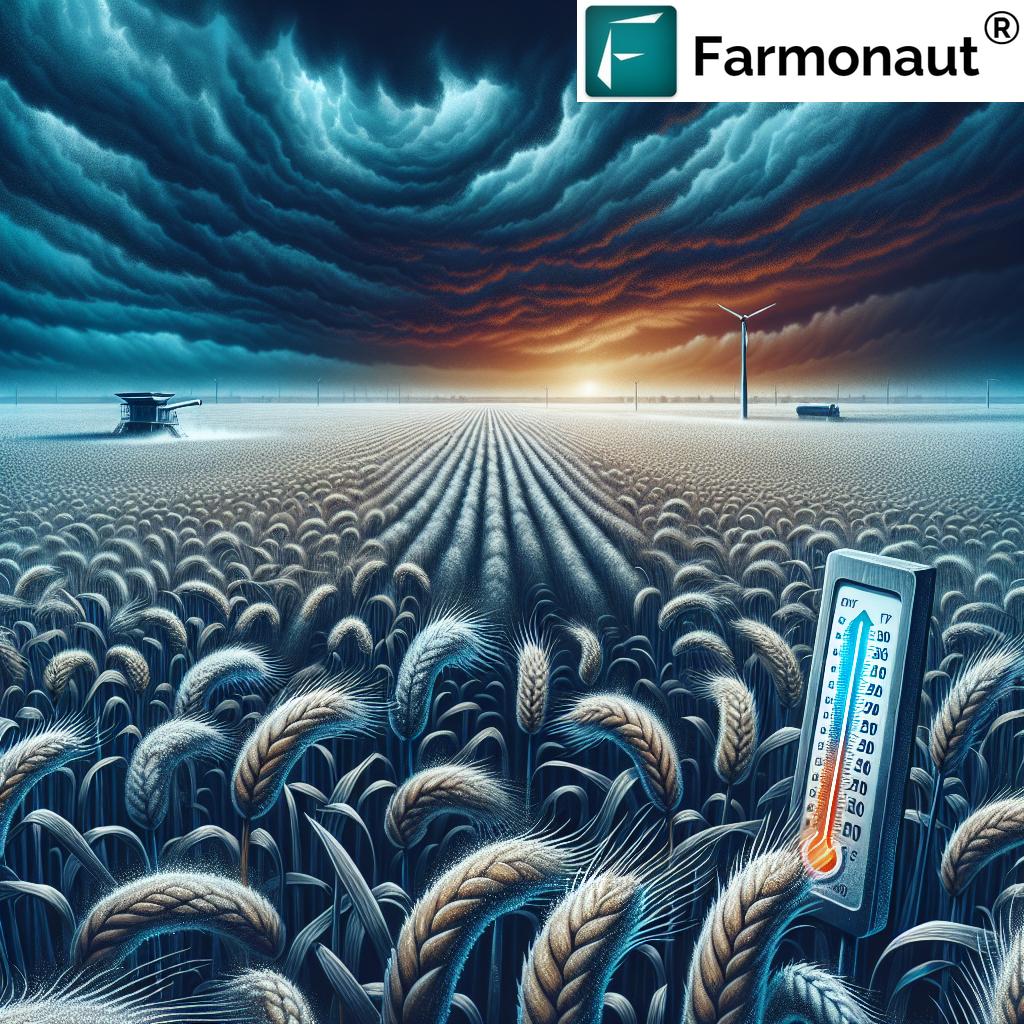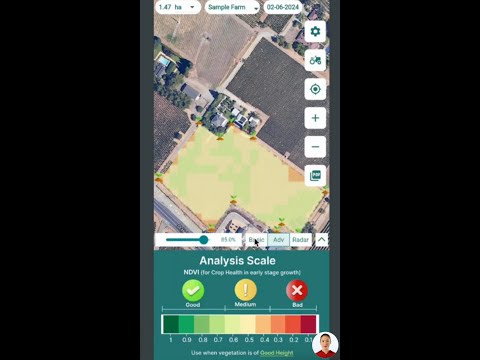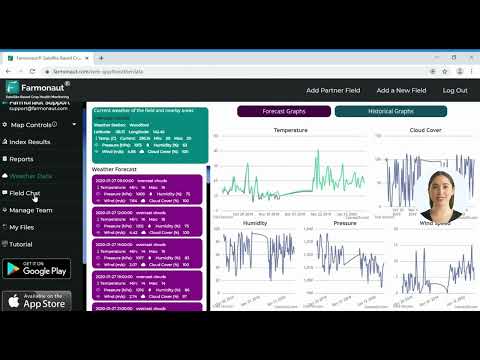Global Wheat Futures Surge: Cold Weather Threatens Black Sea and U.S. Plains Crops

“Global wheat futures hit a 4-month high due to cold weather threats in key growing regions.”
In the ever-evolving landscape of agricultural commodities trading, we find ourselves amidst a significant market shift. Global wheat futures prices have surged to a four-month high, driven by concerns over cold weather threatening crops in key growing regions. This comprehensive market analysis delves into the latest trends in agricultural commodities trading, with a particular focus on wheat, corn, and soybean market dynamics.
As agricultural technology experts at Farmonaut, we understand the critical role that accurate, real-time information plays in navigating these market fluctuations. Our satellite-based crop monitoring solutions provide invaluable insights to farmers and traders alike, helping them make informed decisions in this volatile environment.
The Perfect Storm: Weather Impacts and Market Dynamics
The recent surge in wheat futures prices can be attributed to a confluence of factors, chief among them being the adverse weather conditions affecting major wheat-producing regions. Let’s break down the key elements driving this market trend:
- Cold Weather Threats: Unusually cold temperatures in the Black Sea region and U.S. Plains have raised concerns about potential crop damage. These areas are crucial for global wheat production, and any significant impact on yield could have far-reaching consequences for global supply.
- Supply Constraints: The threat to crops comes at a time when global grain supply forecasts are already tight. This has amplified market sensitivity to any potential disruptions.
- Export Quotas: Russia, the world’s largest wheat exporter, has implemented export quotas, further tightening the global supply outlook.
- Short-Covering Activities: The market has seen an increase in short-covering by speculators, adding to the upward pressure on prices.
To better understand these market dynamics, let’s take a closer look at the comparative wheat futures prices across key global markets:
| Market Location | Current Wheat Futures Price ($/bushel) | Price Change (last 30 days) | Percentage Change (%) | Key Factors Influencing Price |
|---|---|---|---|---|
| Chicago (CBOT) | 5.95 | +0.45 | +8.2% | Cold weather in U.S. Plains, short-covering |
| Paris (Euronext) | 6.20 | +0.38 | +6.5% | European crop concerns, Black Sea tensions |
| Russian Black Sea | 6.10 | +0.52 | +9.3% | Export quotas, cold weather threats |
| Kansas City (KCBT) | 6.05 | +0.48 | +8.6% | U.S. winter wheat concerns |
| Minneapolis (MGEX) | 6.15 | +0.41 | +7.1% | Spring wheat planting uncertainties |
This table clearly illustrates the upward trend in wheat futures prices across major global markets, with the Russian Black Sea region showing the most significant percentage increase due to the combined impact of export quotas and weather concerns.
Wheat Market: A Closer Look
The Chicago Board of Trade (CBOT) wheat futures contract, a benchmark for global wheat prices, has seen a remarkable rally. As of the latest trading session, the most active wheat contract was priced at $5.95 per bushel, a slight decrease from the four-month high of $6.03 reached on Friday. This represents a significant jump from recent lows and underscores the market’s sensitivity to potential supply disruptions.
Several factors are contributing to this bullish trend in wheat futures:
- Weather Concerns: Cold temperatures in key growing regions like Russia and the U.S. Plains could potentially damage dormant crops, especially in areas lacking sufficient snow cover for insulation.
- Export Dynamics: Russian wheat export prices have risen for four consecutive weeks as an export quota came into effect, limiting shipments from the world’s largest wheat supplier.
- Global Demand: Despite price increases, demand remains strong. Saudi Arabia’s main state wheat buying agency recently purchased about 920,000 metric tons of wheat in an international tender, highlighting the ongoing global appetite for the grain.

Corn and Soybean Markets: Interconnected Trends
While wheat has taken center stage, corn and soybean futures are also experiencing notable movements:
- Corn Futures: CBOT corn futures fell 0.5% to $4.94 a bushel, retreating from Friday’s peak of $5, which marked its highest level since October 2023. The corn market is closely tied to wheat, often following similar trends due to their interchangeability in some applications, particularly animal feed.
- Soybean Futures: CBOT soybeans were down 0.7% at $10.29-1/4 per bushel, having drifted from a 6-1/2-month high of $10.80 reached earlier this month. Unlike wheat and corn, soybean supply is forecast to be more plentiful, which has tempered price increases.
These interconnected trends highlight the complex nature of agricultural commodities trading, where shifts in one market can have ripple effects across others.
Global Crop Conditions: A Mixed Picture
As we analyze the global grain supply forecast, it’s crucial to consider crop conditions in various key producing regions:
- France: The condition of France’s wheat crop has worsened sharply due to wet winter weather, according to data from farm office FranceAgriMer. This situation in Europe’s largest wheat producer adds another layer of uncertainty to global supply projections.
- Argentina: Weekend rains in Argentina have helped prevent further losses in 2024/25 soybean and corn crops. However, these crops have already been impacted by drought, underscoring the ongoing challenges faced by farmers in South America.
- Brazil: The 2024/25 soybean harvest in Brazil, the world’s largest producer, was 23% complete as of last Thursday. While this massive harvest is progressing, it’s lagging behind last year’s pace, which could impact global supply timelines.
At Farmonaut, our satellite-based crop monitoring technology provides real-time insights into crop health and development across these regions. This information is crucial for farmers, traders, and policymakers in making informed decisions amidst changing weather patterns and market conditions.
The Role of Technology in Modern Agriculture
In today’s rapidly changing agricultural landscape, technology plays a pivotal role in helping farmers and agribusinesses navigate market uncertainties and optimize their operations. Farmonaut’s suite of advanced solutions, including satellite-based crop monitoring, AI-driven advisory systems, and blockchain-based traceability, are at the forefront of this agricultural revolution.
Our technologies enable:
- Real-time Crop Health Monitoring: Farmers can track the health of their crops using multispectral satellite imagery, allowing for timely interventions and optimized resource allocation.
- Precision Agriculture: By providing detailed insights into soil moisture, vegetation health, and other critical metrics, we help farmers make data-driven decisions that improve yields and reduce waste.
- Market Intelligence: Our comprehensive data analysis helps traders and policymakers understand current crop conditions and forecast potential market movements.
As we continue to witness volatility in agricultural commodities markets, the importance of leveraging technology for informed decision-making cannot be overstated. Farmonaut’s solutions are designed to empower stakeholders across the agricultural value chain, from individual farmers to large agribusinesses and government institutions.
Looking Ahead: Market Outlook and Considerations
As we navigate these turbulent market conditions, several key factors will continue to influence agricultural commodities trading in the coming months:
- Weather Patterns: Continued monitoring of weather conditions in key growing regions will be crucial. Any further adverse weather events could exacerbate supply concerns and drive prices higher.
- Export Policies: Changes in export quotas or trade policies, particularly from major exporters like Russia, could significantly impact global supply and prices.
- Global Economic Factors: The strength of the U.S. dollar and overall economic conditions will continue to influence agricultural exports and pricing.
- Geopolitical Tensions: Ongoing conflicts and trade disputes could disrupt supply chains and affect market dynamics.
- Technological Advancements: The increasing adoption of precision agriculture technologies, like those offered by Farmonaut, could lead to improved yields and more accurate supply forecasts.
“Winter wheat crop conditions in France and Saudi Arabia’s buying patterns influence global grain markets.”
In conclusion, the current surge in wheat futures prices, coupled with the interconnected movements in corn and soybean markets, underscores the complex and dynamic nature of agricultural commodities trading. As weather concerns, export policies, and global demand patterns continue to evolve, staying informed and leveraging cutting-edge technology will be key to success in this sector.
At Farmonaut, we remain committed to providing the tools and insights necessary for navigating these challenges. Our satellite-based crop monitoring, AI-driven advisory systems, and blockchain-based traceability solutions are designed to empower farmers, traders, and policymakers with the information they need to make informed decisions in an ever-changing agricultural landscape.
Explore Farmonaut’s API for advanced agricultural data analysis
Access our comprehensive API Developer Docs
Harnessing Technology for Agricultural Success
As we navigate the complexities of global agricultural markets, it’s clear that technology will play an increasingly vital role in ensuring food security and market stability. Farmonaut’s suite of tools offers a comprehensive approach to modern farming and agricultural trading:
- Satellite-Based Crop Monitoring: Our advanced satellite imagery provides real-time insights into crop health, allowing for timely interventions and optimized resource allocation.
- AI-Driven Advisory: The Jeevn AI system offers personalized recommendations based on real-time data, helping farmers make informed decisions about crop management.
- Blockchain Traceability: Our blockchain solutions ensure transparency and trust throughout the agricultural supply chain, from farm to consumer.
- Resource Management: Farmonaut’s tools help agribusinesses optimize their operations, from fleet management to carbon footprint tracking.
By leveraging these technologies, stakeholders across the agricultural sector can better prepare for and respond to market fluctuations, weather events, and changing global demands.
The Future of Agricultural Commodities Trading
As we look to the future, several trends are likely to shape the landscape of agricultural commodities trading:
- Increased Use of Data Analytics: The integration of big data and AI in agriculture will lead to more accurate yield predictions and market forecasts.
- Climate-Resilient Farming: As weather patterns become more unpredictable, technologies that help farmers adapt to climate change will become increasingly important.
- Sustainable Agriculture: There will be a growing focus on sustainable farming practices, driven by both consumer demand and environmental concerns.
- Precision Agriculture: Technologies that enable targeted interventions and resource optimization will become standard in modern farming.
- Blockchain in Supply Chains: The use of blockchain for traceability and transparency in agricultural supply chains is likely to expand.
Farmonaut is at the forefront of these trends, continuously innovating to meet the evolving needs of the agricultural sector. Our commitment to making precision agriculture affordable and accessible aligns perfectly with these future directions.
Empowering Stakeholders Across the Agricultural Value Chain
Farmonaut’s solutions are designed to benefit a wide range of stakeholders in the agricultural ecosystem:
- Farmers: From small-scale farmers to large agribusinesses, our tools provide valuable insights for optimizing crop yields and resource management.
- Traders: Real-time crop data and market insights help traders make informed decisions in volatile markets.
- Financial Institutions: Our satellite-based verification services assist banks and insurance companies in assessing agricultural risks more accurately.
- Policymakers: Comprehensive data on crop conditions and yields can inform agricultural policies and food security strategies.
- Consumers: Increased transparency in the food supply chain leads to greater trust and informed choices.
Earn With Farmonaut: Join our affiliate program and earn 20% recurring commission by helping farmers save 10%. Onboard 10 Elite farmers monthly to earn a minimum of $148,000 annually—start now and grow your income!
Conclusion: Navigating the Future of Agriculture
The recent surge in wheat futures prices, driven by cold weather threats in key growing regions, serves as a stark reminder of the volatility inherent in agricultural markets. As we’ve explored in this analysis, factors ranging from weather patterns to export policies and global demand can have significant impacts on commodity prices and food security.
In this complex and ever-changing landscape, the role of technology in agriculture has never been more crucial. Farmonaut’s suite of advanced solutions, from satellite-based crop monitoring to AI-driven advisory systems, provides the tools necessary for stakeholders to navigate these challenges effectively.
As we move forward, the integration of precision agriculture technologies, sustainable farming practices, and data-driven decision-making will be key to ensuring global food security and market stability. By leveraging these innovations, we can create a more resilient, efficient, and sustainable agricultural sector capable of meeting the demands of a growing global population.
At Farmonaut, we remain committed to driving this technological revolution in agriculture, making precision farming accessible to all and empowering stakeholders across the value chain. Together, we can build a future where agriculture is not only more productive but also more sustainable and resilient in the face of global challenges.
Farmonaut Subscriptions
Frequently Asked Questions
- What factors are driving the current surge in wheat futures prices?
The surge is primarily driven by cold weather threats in key growing regions like the Black Sea and U.S. Plains, coupled with tight global supply forecasts and export quotas from major producers like Russia. - How are corn and soybean markets affected by the wheat price surge?
Corn futures have followed a similar upward trend, while soybean futures have seen more moderate increases due to forecasts of more plentiful supply. - What role does technology play in modern agricultural commodities trading?
Technology, such as Farmonaut’s satellite-based crop monitoring and AI-driven advisory systems, provides real-time insights into crop conditions, helping farmers, traders, and policymakers make informed decisions. - How can farmers use Farmonaut’s solutions to optimize their operations?
Farmonaut offers tools for real-time crop health monitoring, precision agriculture, and resource management, allowing farmers to make data-driven decisions that improve yields and reduce waste. - What are the key trends shaping the future of agricultural commodities trading?
Key trends include increased use of data analytics, climate-resilient farming practices, sustainable agriculture, precision farming technologies, and blockchain integration in supply chains.
For more information on how Farmonaut can help you navigate the complexities of modern agriculture, visit our website or contact our team of experts today.







